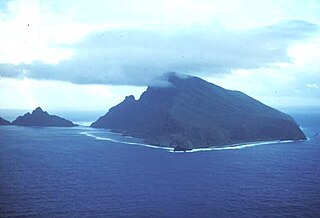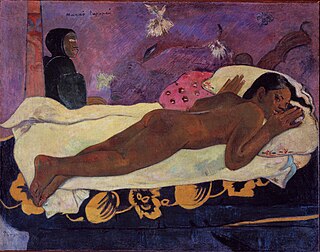Related Research Articles

Polynesian mythology encompasses the oral traditions of the people of Polynesia together with those of the scattered cultures known as the Polynesian outliers. Polynesians speak languages that descend from a language reconstructed as Proto-Polynesian – probably spoken in the Tonga and Samoa area around 1000 BC.
Atua are the gods and spirits of the Polynesian peoples such as the Māori or the Hawaiians ; the Polynesian word literally means "power" or "strength" and so the concept is similar to that of mana. Today, it is also used for the monotheistic conception of God. Especially powerful atua included:
Samoan culture tells stories of many different deities. There were deities of the forest, the seas, rain, harvest, villages, and war. There were two types of deities, atua, who had non-human origins, and aitu, who were of human origin.
In the traditions of ancient Hawaiʻi, Kanaloa is a god symbolized by the squid or by the octopus, and is typically associated with Kāne. It is also an alternative name for the island of Kahoʻolawe.
In Samoan mythology, Tagaloa is generally accepted as the supreme ruler, the creator of the universe, the chief of all gods and the progenitor of other gods. Tagaloa Lagi dwelt in space and made the Heavens the sky, the land, the seas, the fresh water, the trees and the people. Samoans believed Tagaloa created nine heavens. Tagaloa's role as paramount deity in the Samoa pantheon bears similarities to the position of Ta'aroa in Tahiti and Io Matua Kore in New Zealand.

In Hawaiian mythology, Laka is the name of two different popular heroes from Polynesian mythology..

The Samoan Islands are an archipelago covering 3,030 km2 (1,170 sq mi) in the central South Pacific, forming part of Polynesia and of the wider region of Oceania. Administratively, the archipelago comprises all of the Independent State of Samoa and most of American Samoa. The land masses of the two Samoan jurisdictions are separated by 64 km (40 mi) of ocean at their closest points.
Paʻao is a figure from Hawaii. He is most likely a Hawaiian historical character retold through Hawaiian legend. According to Hawaiian tradition and folklore, he is said to have been a high priest from Kahiki, specifically "Wewaʻu" and "ʻUpolu." In Hawaiian prose and chant, the term "Kahiki" is applied in reference to any land outside of Hawaii, the linguistic root is conclusively derived from Tahiti. "Upolu" point to actual places in, Samoa, and Hawaiian scholars and royal commentators consistently claim Paʻao came from Samoa.
Samoan Americans are Americans of Samoan origin, including those who emigrated from the United States Territory of American Samoa and immigrants from the Independent State of Samoa to the United States. Samoan Americans are Pacific Islanders in the United States Census, and are the second largest Pacific Islander group in the U.S., after Native Hawaiians.
Lilikalā K. Kameʻeleihiwa is a Hawaiian historian, filmmaker, and senior professor at the University of Hawaiʻi's Kamakakūokalani Center for Hawaiian Studies. Her earliest work was published under the name of Lilikalā L. Dorton.

Pacific Islander Americans are Americans who are of Pacific Islander ancestry. For its purposes, the United States census also counts Aboriginal Australians as part of this group.
In Samoan legend, the mythological figure Tiʻitiʻi Atalaga appears in legends very similar to those recounting the tales of the demigod Māui, found in other island cultures. In one such legend, which is almost identical to the New Zealand fire myth of Māui Tikitiki-a-Taranga, he succeeds in bringing fire to the people of Samoa after a battle with the earthquake god, Mafuiʻe. During the battle, Ti'iti'i breaks off one of Mafui'e's arms, forcing him to agree to teach him of how fire had been concealed by the gods in certain trees during the making of the world. The people of Samoa were thankful to Ti'iti'i for breaking off Mafui'e's arm, as they believed that he was less able to create large earthquakes as a result.
Micronesian mythology comprises the traditional belief systems of the people of Micronesia. There is no single belief system in the islands of Micronesia, as each island region has its own mythological beings.

The Samoa flying fox or Samoan flying fox is a species of flying fox in the family Pteropodidae. It is found in American Samoa, Fiji, and Samoa. Its natural habitat is subtropical or tropical dry forests.
Saveasiʻuleo is the God of Pulotu the underworld of spirits or Hades in Samoan mythology.

Sina and the Eel is a myth of origins in Samoan mythology, which explains the origins of the first coconut tree.

There was widespread belief in ghosts in Polynesian culture, some of which persists today. After death, a person's ghost would normally travel to the sky world or the underworld, but some could stay on earth. In many Polynesian legends, ghosts were often involved in the affairs of the living. Ghosts might also cause sickness or even invade the body of ordinary people, to be driven out through strong medicines.
The COVID-19 pandemic in American Samoa is part of the ongoing worldwide pandemic of coronavirus disease 2019 caused by severe acute respiratory syndrome coronavirus 2. The COVID-19 pandemic was confirmed to have reached the unincorporated United States territory of American Samoa on 9 November 2020.